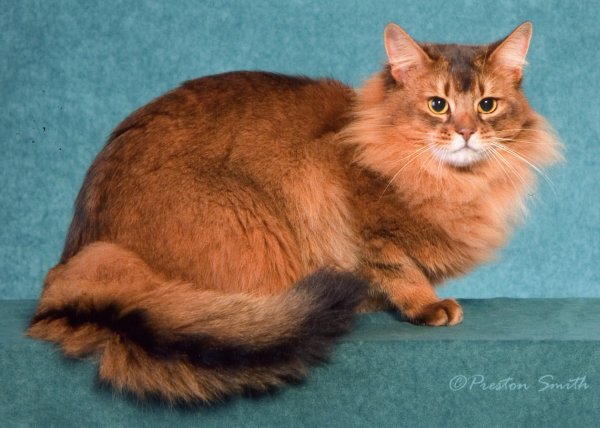 American Cat Fanciers Association
American Cat Fanciers Association
Somali Breeders' Directory
~~~~~~~~~~~~~~~~~~~~~~~~~~~~~~~~~~~~~~~~~~~~~~~~~~~~~~~~~~~
Glowing Ticked Coat A Breed Is Born
Somali cats and their short haired cousins, the Abyssinians, are unique
in the pedigreed cat world because these breeds are based on a coat
pattern found in no other breed. Abys and Somalis have ticked coats that
resemble fox fur. Each hair is striped with four to 12 bands of color
that alternate, light and dark, light and dark. This is what gives their
coats a “salt and pepper” appearance. In natural light, their coats glow
with a rich mixture of warm, earthy colors. The Somali’s ticked coat is
silkier than the Aby’s. The tail forms a full brush. They have a ruff
around their neck (this takes a few years to develop fully and is more
obvious in males), and ample breeches, giving a full-coated look. Somali
breeders must be patient––it takes as long as 18 months for the full
color and pattern of ticking to develop. In ACFA, Somalis are available
in four colors: Ruddy, Red, Blue, and Fawn. The color of their paw pads
varies with the coat color from black in the Ruddies, through mauve to
pink for the other colors. Their eyes can be green or gold; the deeper
the color the better. Somalis’ eyes are accentuated with dark vertical
marks above, zigzag lines leading back toward the ears, and solid dark
eyelid lines contrasting against light fur around each almond-shaped
eye.
Ancient Egyptians
The Somali and its short haired parent breed, the Abyssinian, are
considered by many to be the closest modern descendants of the sacred
cats of Ancient Egypt. They certainly resemble many of the ancient
bronze sculptures and paintings of cats found in Egyptian tombs––the
same body type, shape of face, erect ears, and large almond-shaped eyes.
English explorers imported the ancestors of our present-day Abyssinians
and Somalis from north Africa to England in the early 1800s. Food
shortages and other problems nearly eliminated the breed during World
War I and again during World War II. Outcross breedings were used to
keep the breed viable, and this may have been when the long hair gene
was introduced to the
Abyssinian breed.
Many breeding lines of Abys carried the recessive longhair gene for
several generations. Although many breeders preferred to deny the fact
and hurriedly neutered or got rid of any unwanted long haired kittens,
others found the cats extremely attractive. In the 1960's breeders in
Canada and the U.S. began seriously breeding Somalis. Evelyn Mague was
an early breeder who persisted in showing the longhairs and finally won
their official acceptance by the Cat Fanciers Association in 1979. She
had the unique honor of naming the breed which she did with a bit of
ironic humor. Since some Aby breeders considered the new longhaired Abys
as interlopers, she chose the name Somali because the ancient nation of
Somalia shares a border with ancient Abyssinia. Thus, she likened the
difference between the breeds to the borders between Somalia and
Abyssinia––as man made.
Personality
Somali cats like to be around people. They are alert and lively and
constantly involved in their human’s activities. If you want a cat that
goes off and leaves you alone, Somali cats are not for you! They have a
naturally happy disposition, much like most dogs. Given the opportunity,
many of them will lick your face and learn to retrieve toys and play
other games. Somalis are intelligent, learn quickly, remember remarkably
well, and stay playful throughout adulthood. They crave attention and
want to stay near their human companions at all times, soliciting
nuzzles and pats. They integrate readily with other animals, but since
they are so outgoing, they tend to want to “run the show.” This usually
isn’t much of a problem since their leadership soon brings out the
playful nature of their companions as well.
Contact Central Office
